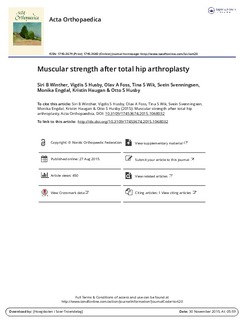Muscular strength after total hip arthroplasty. A prospective comparison of 3 surgical approaches
Winther, Siri Bjørgen; Husby, Vigdis Schnell; Foss, Olav Andreas; Wik, Tina Strømdal; Svenningsen, Svein; Engdal, Monika; Haugan, Kristin; Husby, Otto Schnell
Journal article, Peer reviewed
Permanent lenke
http://hdl.handle.net/11250/2366340Utgivelsesdato
2015Metadata
Vis full innførselSamlinger
Sammendrag
Background and purpose — Minimizing the decrease in muscular strength after total hip arthroplasty (THA) might allow patients to recover faster. We evaluated muscular strength in patients who were operated on using 3 surgical approaches.
Patients and methods — In a prospective cohort study, 60 patients scheduled for primary THA were allocated to the direct lateral, posterior, or anterior approach. Leg press and abduction strength were evaluated 2 weeks or less preoperatively, 2 and 8 days postoperatively, and at 6-week and 3-month follow-up.
Results — Differences in maximal strength change were greatest after 2 and 8 days. The posterior and anterior approaches produced less decrease in muscular strength than the direct lateral approach. 6 weeks postoperatively, the posterior approach produced greater increase in muscular strength than the direct lateral approach, and resulted in a greater increase in abduction strength than the anterior approach. At 3-month follow-up, no statistically significant differences between the groups were found. The operated legs were 18% weaker in leg press and 15% weaker in abduction than the unoperated legs, and the results were similar between groups.
Interpretation — The posterior and anterior approaches appeared to have the least negative effect on abduction and leg press muscular strength in the first postoperative week; the posterior approach had the least negative effect, even up to 6 weeks postoperatively. THA patients have reduced muscle strength in the operated leg (compared to the unoperated leg) 3 months after surgery.
